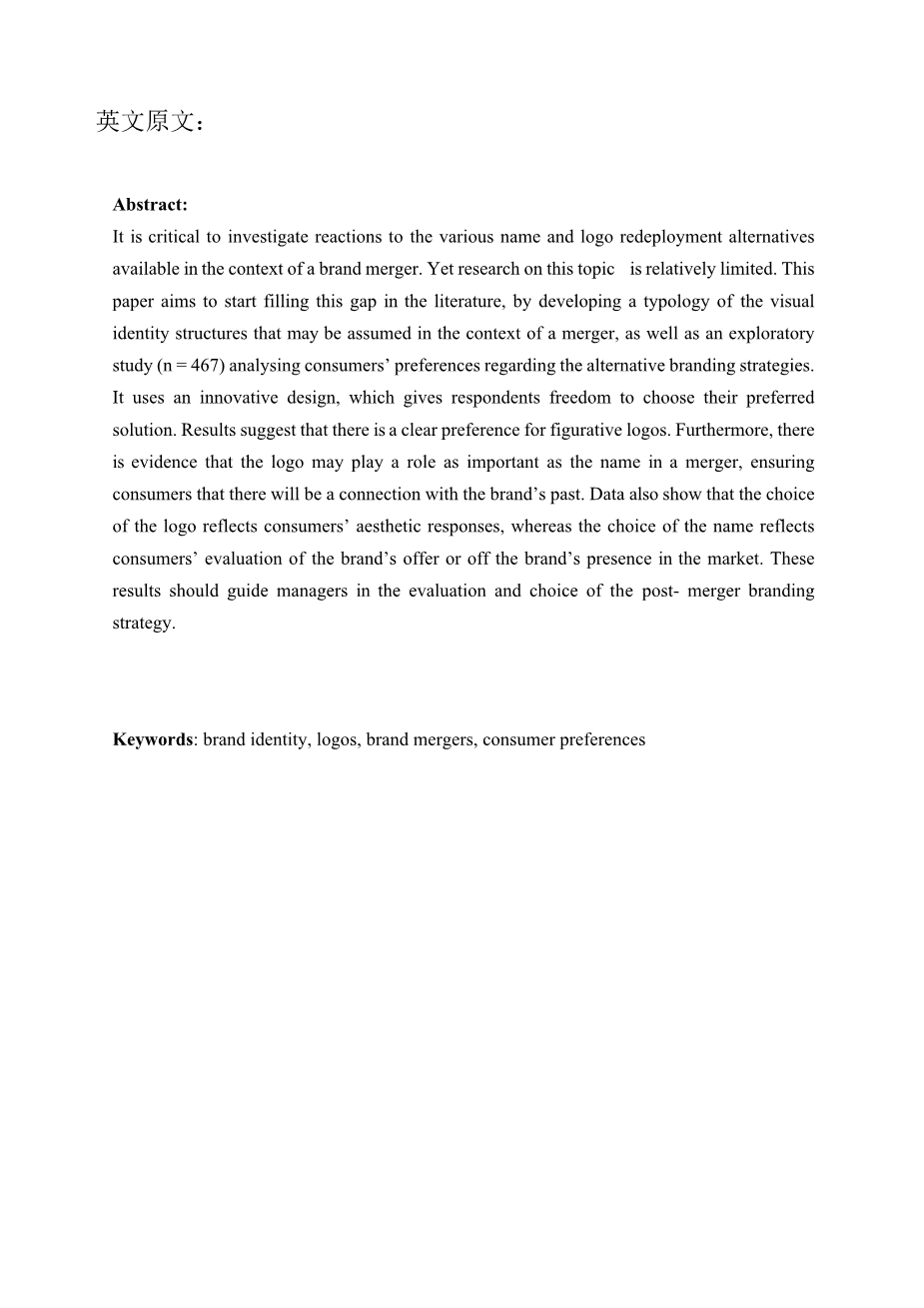英文原文:
Abstract:
It is critical to investigate reactions to the various name and logo redeployment alternatives available in the context of a brand merger. Yet research on this topic is relatively limited. This paper aims to start filling this gap in the literature, by developing a typology of the visual identity structures that may be assumed in the context of a merger, as well as an exploratory study (n = 467) analysing consumersrsquo; preferences regarding the alternative branding strategies. It uses an innovative design, which gives respondents freedom to choose their preferred solution. Results suggest that there is a clear preference for figurative logos. Furthermore, there is evidence that the logo may play a role as important as the name in a merger, ensuring consumers that there will be a connection with the brandrsquo;s past. Data also show that the choice of the logo reflects consumersrsquo; aesthetic responses, whereas the choice of the name reflects consumersrsquo; evaluation of the brandrsquo;s offer or off the brandrsquo;s presence in the market. These results should guide managers in the evaluation and choice of the post- merger branding strategy.
Keywords: brand identity, logos, brand mergers, consumer preferences
Introduction
Name and logo are key components of brand identity, since they are the most pervasive elements in corporate and brand communications, and provide instant recognition to the brand (Schecther, 1993; Henderson and Cote, 1998). Furthermore, name and logo are the official representations of the brandrsquo;s meaning and a play a crucial role in the communication of the brandrsquo;s characteristics (Henderson and Cote, 1998; Van Riel and Van den Ban, 2001). Mergers are one of the most frequent reasons for organizations electing to change their name and logo (Muzellec and Lambkin, 2006). Moreover, the choice of the post-merger branding strategy is one of the more important organizational and marketing questions that arises in mergers (Balmer and Dinnie, 1999; Brooks, Rossman and Grassman, 2005; Melewar, 2001). Yet, relatively little academic attention has been paid to the different name and logo options available to the new corporate entity, and to our knowledge no empirical research has addressed the branding strategies from the perspective of individual consumers. This paper seeks to address this research gap, by developing a model of consumersrsquo; brand identity preferences, in the context of a merger. Specifically, it considers the degree to which name and logo design characteristics influence consumer responses.
The paper is set out as follows: we begin by reviewing relevant brand identity and logo literature, and discuss specifically the impact of a merger on corporate name and logo. Then, the study is described, the research results are presented and discussed, limitations noted and research directions outlined.
Literature Review
Brand and brand identity
Branding is a central concept in marketing, and the particular importance of corporate branding has been highlighted by a number of writers (Keller and Richey, 2006; Merriles and Miller, 2008). Although this increasing interest in branding, we may say that its incorporation into the conceptual structure of marketing is still not completely consolidated (Stern, 2006).
In the search of an holistic conceptualization, we assume a semiotics based conceptual model for branding, according to which the brand is founded on three fundamental pillars: the identity pillar, which includes the sign or signs that identify the brand (name, logo, slogan,
...identity mix) and the brands associated to it, thus building the corporate identity structure; the object pillar, which includes the different offers of the brand together with the organization and the marketing activities which support them; the market pillar, which includes the brandrsquo;s stakeholders and their different responses to the brand at a cognitive, affective and behavioural level (Mollerup, 1997; Lencastre, and Cocirc;rte-Real, 2010).
Name and logo are generally considered the main brand identity signs, since they are critical communication cues (Henderson and Cote, 2003; Pittard, Ewing and Jevons, 2007; Van den Bosch and de Jong, 2005). Development of a strong logo is particularly relevant for services organizations, because of the intangible nature of their offerings (Berry, 2000; De Chenatony and Segal-Horn, 2003, Devlin and McKechnie, 2008). Several marketing scholars have underlined the need to link intangible service offers to tangible logos in order to convey appropriate meanings (Miller, Foust and Kilic, 2007).
Logo design
Prior research recognizes logos play a critical role in brand building, because they act as the primary visual representation of the brandrsquo;s meaning and serve as the summary information about the brandrsquo;s marketing effort (Henderson and Cote, 1998; MacInnis, Shapiro and Mani,
1999). Yet, there is little systematic research on the effect of logo design on brand evaluation and preference. In one exception, Henderson and Cote (1998) showed that design characteristics influence cognitive and af
剩余内容已隐藏,支付完成后下载完整资料

英语译文共 37 页,剩余内容已隐藏,支付完成后下载完整资料
资料编号:[259670],资料为PDF文档或Word文档,PDF文档可免费转换为Word
以上是毕业论文外文翻译,课题毕业论文、任务书、文献综述、开题报告、程序设计、图纸设计等资料可联系客服协助查找。


